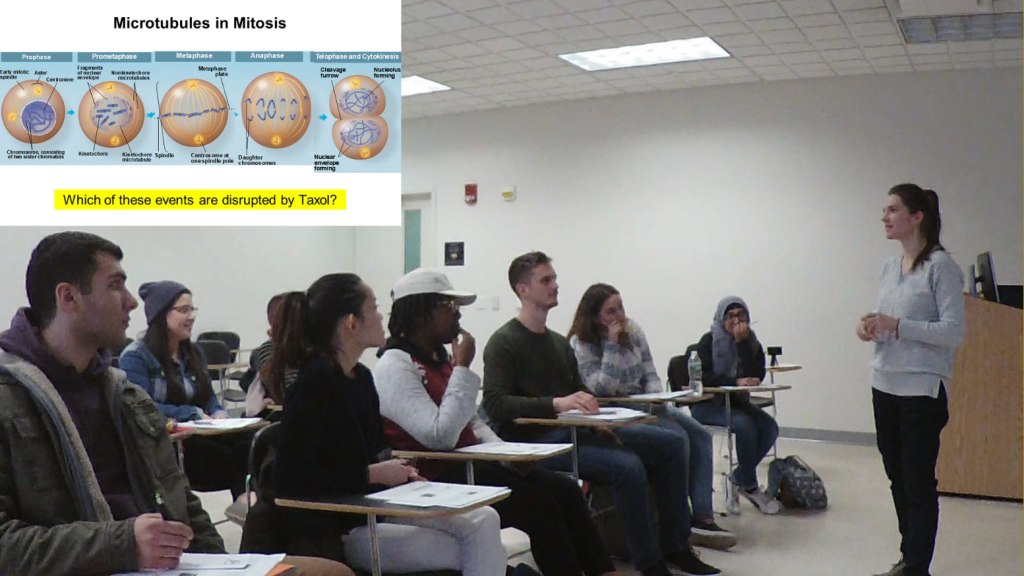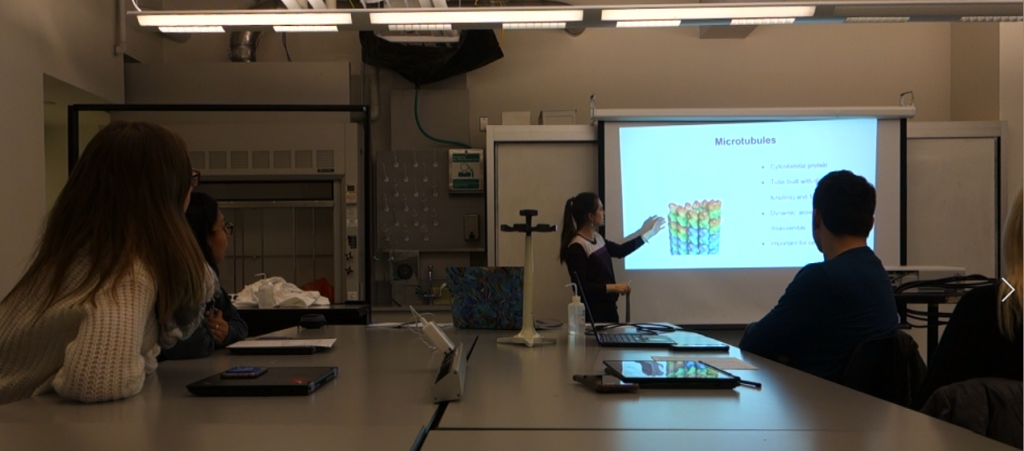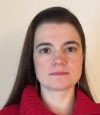Table of Contents
Classroom Experience

William Paterson University
Wayne, NJ — 2015-2018
Teaching Fellow in IRACDA/INSPIRE program, Biology Department
Developed Instructor and Student materials for two Introductory Biology I Lab Modules on Quantitative techniques that are now used each semester by 11 lab sections (over 200 students). Taught the modules three times and revised the materials.
1)Graphing, data interpretation and linear relationship in biology. Incorporated case-based activity that reinforces understanding of scientific inquiry, use of three major types of graphs and includes group work.
2) Molarity, solution concentrations, and dilutions; pH. Incorporated hands-on activities and visualizations to stimulate discussion and develop intuition for doing calculations.
Developed lecture plans, student packets and taught Introductory Biology I Lectures on Mitosis, Meiosis. Incorporated active learning activities such as pair-share and report exercises and documenting observations based on animation of cell division process.
Originated and established Mentoring sessions initiative for three Rutgers IRACDA partner schools with the goal of broadening participation of diverse scientists in biomedical research. In collaboration with other IRACDA fellows, developed and lead more than eight mentoring sessions on undergraduate research opportunities and graduate school. Designed assessment forms and evaluated outcomes of the sessions which included better understanding of application process, value of research experience and research-related career opportunities as well as recruitment to Rutgers summer research program.
Teaching Advisor: Emily Monroe, PhD
Simmons University
Boston, MA — Fall, 2014
Guest Lecturer, Chemistry Department
Two computational science modules in an interdisciplinary problem-based class for freshmen
Lecture Topic: Introduction to computational thinking (Exponential and Logistic Growth)
Course: Your Microbes and You, Honors Class
Instructor: Jennifer A. Roecklein-Canfield, PhD
Oregon State University
Corvallis, OR — 2012-2014
Developed lessons on computational approaches in science for pre-service teachers
Project Title: INSTANCES (Incorporating Computational Scientific Thinking Advances into Education & Science Courses)
Project Primary Investigators and leaders: Rubin Landau, PhD Raquell Holmes, PhD, Namhwa Kang, PhD
University of Connecticut Health Center
Farmington, CT — 2008-2015
Instructor in Virtual Cell (biochemical modeling software) in Logic of Modern Biology first-year graduate course, 2008
Instructor in Virtual Cell three-day course offered annually by Center for
Cell Analysis and Modeling, 2008-2015
National Institute for Mathematical and Biological Synthesis (NIMBioS), University of Tennesse
Knoxville, TN — April 2013
Initiated collaboration between Center for Cell Analysis and Modeling and NIMBioS that resulted in organizing Mathematical Modeling for the Cell Biology Researcher and Educator Tutorial
Lead session “Integrating modeling into curriculum” with case-based learning presentation/demo · Instructed participants in implementing Virtual Cell biochemical modeling projects. Organized and structured curricular materials for the tutorial.
Students Testimonials
Feedback from Introductory Biology I – Labs: Graphing, Concentrations and Dilutions
What were your favorite activities or methods that Dr. Borinskaya used? Was there something done differently or a teaching approach that stood out?
“Dr. Borinskaya would always ask questions in class and ask us to tell her what we do not understand about what she is teaching.”
“She made the class very interesting by engaging us on the material with fun activities.”
“I appreciated how interactive her teaching style was and I liked when she taught us how to do slope.”
“She was creative with how we introduced ourselves.”
“The case study activities. The name game is what stood out to me.”
“Her powerpoints were my favorite.”
“I liked how she thoroughly explained everything and helped us with pictures. She used different methods to explain things so it could incorporate everything.”
“My favorite method was how interactive she was with the students. She was well prepared with her lesson plan.”
“Dr. Borinskaya called on multiple people to answer questions instead of her answering them.”
“I liked how she put group together for the activities and gave us enough time to answer.”
Briefly describe what you learned about research or science careers, if anything new.
“Science is fun!”
“It involves a lot of thinking and group work.”
“There is a lot of thought that goes into planning experiments.”

Feedback from Introductory Biology I – Lectures: Mitosis, Meiosis
What were your favorite activities or methods that Dr. Borinskaya used? Was there something done differently or a teaching approach that stood out?
“Teaching method was activity oriented, where students learned through activities and discussion of observations.”
“She gave us notes that we filled in as she went along, which I really liked. She put pictures in her notes as well, which helps people like me who are visual learners.”
“She used helpful videos and provided worksheets to fill out as we went through the videos. They helped to identify the components of the video that were important and organized the information in a way that was understandable.”
“I appreciated her handouts. It made following along to her lecture a lot easier. She was very engaging and interacted with the class. She did not just read off the slide and lecture.”
“Favorite activity was to work in groups or pairs to do an activity. Her drawings helped me understand better.”
“Pre-class work, using animation and not the regular drawings to explain the concepts.”
“The table we had to fill out after watching videos was a good activity.”
“The chart was a big help.”
Briefly describe what you learned about research or science careers, if anything new.
“Research could help you get jobs.”
“… there’s a research internship at Rutgers.”
Directly Supervised undergraduate students (research interns)
Anya Lopez
- (freshman, Rutgers University), Spring and Summer 2018
- Project: Computational Model of Cadherin Trafficking
This project investigates how branched actin networks affect the process of Cadherin trafficking. Cadherin is a transmembrane adhesion molecule that holds together two neighboring cells at the Apical Junction(AJ). Cadherins are constantly turned over by the trafficking mechanisms (Figure 1) which include the processes of endocytosis and recycling back to the junction. Cadherin level at AJ is higher and it turns over faster in embryos depleted of trafficking regulator RME-1 and branched actin regulator WAVE-1 compared to wild type animals. The model will allow to explain these phenotypes using multiple hypotheses some of which are not testable experimentally. For example, a range of trafficking reaction rates can be used in a virtual experiment. In addition, variety of vesicle and cell geometries can be applied to each experiment.
Anya and I developed a preliminary model in the Virtual Cell (VCell) computational modeling environment. VCell is designed for modeling cell biological systems. With its biology-based interface it is perfectly suitable for beginner modelers and also offers full access to the math/equations. Cadherin transitions between the membranes of Golgi, Early Endosomes, apical junction and basal surface of the plasma membrane.
Jeff Martinez
- Jeff Martinez (senior, New Jersey City University), Summer 2018
- Project: Role of linear actin nucleators in C. elegans pharynx development
Angelica Barreto-Galvez
- Angelica Barreto-Galvez (senior, New Jersey City University), Summer 2017
- Project: Role of linear actin nucleators in C. elegans pharynx development
This project investigates role of linear actin nucleators in C. elegans development and morphogenesis. Previous work in the Soto lab showed that branched actin plays primary roles in ventral enclosure and nuclear migration during morphogenesis. The roles of linear actin and linear actin nucleators (formins) in a live developing organism were not extensively characterized. Main catalytic function of formins is to elongate actin filaments by processivity adding actin monomers to the growing ends of the filaments. There are seven formin proteins in C. elegans: FOZI-1, INFT-1/EXC-6, DAAM-1, FRL-1, INFT-2, PHOD-1, and CYK-1. With Angelica and Jeff we have found that all seven formins cause morphogenesis defects in worm embryos. We have also showed that pharyngeal lumen is wider in embryos depleted of CYK-1 and INFT-1
